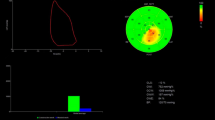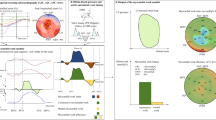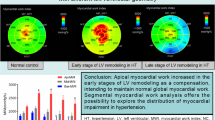Abstract
Concentric LV remodeling and hypertrophy are common structural abnormalities in patients with heart failure with preserved ejection fraction (HFpEF) and tend to be accompanied by impaired LV function. Assessment of global myocardial work (GMW) using strain-pressure loop may provide more comprehensive assessment of LV myocardial function, overcoming the limitations of the conventional parameters. We investigated the value of GMW in patients with HFpEF and assessed the relationship of GMW with concentric remodeling and hypertrophy. Consecutive patients with HFpEF (n = 107) and sex-matched healthy controls (n = 32) were prospectively enrolled. Clinical and conventional echocardiography variables were obtained. Further analyses of offline data were performed to obtain GMW indices including global work index (GWI), global constructive work (GCW), global waste work (GWW), and global work efficiency (GWE). Association of concentric remodeling and hypertrophy with GMW was analyzed by univariate and multivariate analysis. HFpEF patients showed lower GWE (94% vs 96%, P < 0.001) and higher GWW (114 mmHg% vs 78 mmHg%, P = 0.003) than control group, while GWI (2111 mmHg% vs 2146 mmHg%, P = 0.877) and GCW (2369 mmHg% vs 2469 mmHg%, P = 0.733) were comparable in the two groups. HFpEF patients with relative wall thickness (RWT) > 0.42 had reduced GWE (94% vs 95%, P = 0.034) compared to HFpEF patients with RWT ≤ 0.42, while GWI, GCW, and GWW were comparable between these two subgroups. Multivariate analysis showed an independent association of RWT with GWI, GCW, and GWE, respectively. Impaired global myocardial work was detected in patients with HFpEF. Impaired LV GMW may be associated with increased RWT.



Similar content being viewed by others
Data availability
All data generated or analysed during this study are included in this published article (and its supplementary information files). The datasets used and/or analysed during the current study are available from the corresponding author on reasonable request.
Abbreviations
- HF:
-
Heart failure
- HFpEF:
-
Heart failure with preserved ejection fraction
- LVEF:
-
Left ventricular ejection fraction
- GLS:
-
Global longitudinal strain
- GMW:
-
Global myocardial work
- GWI:
-
Global work index
- GCW:
-
Global constructive work
- GWW:
-
Global waste work
- GWE:
-
Global work efficiency
- RWT:
-
Relative wall thickness
- LVMi:
-
Left venricular mass index
References
Borlaug BA (2020) Evaluation and management of heart failure with preserved ejection fraction. Nat Rev Cardiol 17(9):559–573
Shah SJ, Borlaug BA, Kitzman DW et al (2020) Research priorities for heart failure with preserved ejection fraction: national heart, lung, and blood institute working group summary. Circulation 141(12):1001–1026
Wang H, Chai K, Du M et al (2021) Prevalence and incidence of heart failure among urban patients in china: a national population-based analysis. Circ Heart Fail 14(10):e8406
Groenewegen A, Rutten FH, Mosterd A et al (2020) Epidemiology of heart failure. Eur J Heart Fail 22(8):1342–1356
Zile MR, Gottdiener JS, Hetzel SJ et al (2011) Prevalence and significance of alterations in cardiac structure and function in patients with heart failure and a preserved ejection fraction. Circulation 124(23):2491–2501
Guan P, Gu J, Song ZP et al (2021) Left ventricular geometry transition in hypertensive patients with heart failure with preserved ejection fraction. ESC Heart Fail 8(4):2784–2790
Yamanaka S, Sakata Y, Nochioka K et al (2020) Prognostic impacts of dynamic cardiac structural changes in heart failure patients with preserved left ventricular ejection fraction. Eur J Heart Fail 22(12):2258–2268
Shimizu I, Minamino T (2016) Physiological and pathological cardiac hypertrophy. J Mol Cell Cardiol 97:245–262
Kosaraju A, Goyal A (2022). Left Ventricular Ejection Fraction. In: StatPearls [Internet]. Treasure Island (FL): StatPearls Publishing; 2022 Jan.
Hasselberg NE, Haugaa KH, Sarvari SI et al (2015) Left ventricular global longitudinal strain is associated with exercise capacity in failing hearts with preserved and reduced ejection fraction. Eur Heart J Cardiovasc Imaging 16(2):217–224
Merken J, Brunner-La RH, Weerts J et al (2018) Heart failure with recovered ejection fraction. J Am Coll Cardiol 72(13):1557–1558
Kraigher-Krainer E, Shah AM, Gupta DK et al (2014) Impaired systolic function by strain imaging in heart failure with preserved ejection fraction. J Am Coll Cardiol 63(5):447–456
Voigt JU, Cvijic M (2019) 2- and 3-Dimensional myocardial strain in cardiac health and disease. JACC Cardiovasc Imaging 12(9):1849–1863
Edwards N, Scalia GM, Shiino K et al (2019) Global myocardial work is superior to global longitudinal strain to predict significant coronary artery disease in patients with normal left ventricular function and wall motion. J Am Soc Echocardiogr 32(8):947–957
Russell K, Eriksen M, Aaberge L et al (2012) A novel clinical method for quantification of regional left ventricular pressure-strain loop area: a non-invasive index of myocardial work. Eur Heart J 33(6):724–733
Russell K, Eriksen M, Aaberge L et al (2013) Assessment of wasted myocardial work: a novel method to quantify energy loss due to uncoordinated left ventricular contractions. Am J Physiol Heart Circ Physiol 305(7):H996–H1003
Smiseth OA, Russell K, Skulstad H (2012) The role of echocardiography in quantification of left ventricular dyssynchrony: state of the art and future directions. Eur Heart J Cardiovasc Imaging 13(1):61–68
D’Andrea A, Ilardi F, D’Ascenzi F et al (2021) Impaired myocardial work efficiency in heart failure with preserved ejection fraction. Eur Heart J Cardiovasc Imaging 22(11):1312–1320
Pieske B, Tschope C, de Boer RA et al (2020) How to diagnose heart failure with preserved ejection fraction: the HFA-PEFF diagnostic algorithm: a consensus recommendation from the heart failure association (HFA) of the European society of cardiology (ESC). Eur J Heart Fail 22(3):391–412
McDonagh TA, Metra M, Adamo M et al (2021) 2021 ESC guidelines for the diagnosis and treatment of acute and chronic heart failure. Eur Heart J 42(36):3599–3726
Masai K, Mano T, Goda A et al (2018) Correlates and prognostic values of appearance of L wave in heart failure patients with preserved vs. reduced ejection fraction. Circ J 82(9):2311–2316
Harada E, Mizuno Y, Kugimiya F et al (2017) B-type natriuretic peptide in heart failure with preserved ejection fraction- relevance to age-related left ventricular modeling in Japanese. Circ J 81(7):1006–1013
Ma YC, Zuo L, Chen JH et al (2006) Modified glomerular filtration rate estimating equation for Chinese patients with chronic kidney disease. J Am Soc Nephrol 17(10):2937–2944
Lang RM, Badano LP, Mor-Avi V et al (2015) Recommendations for cardiac chamber quantification by echocardiography in adults: an update from the American society of echocardiography and the european association of cardiovascular imaging. J Am Soc Echocardiogr 28(1):1–39
Smiseth OA, Donal E, Penicka M et al (2021) How to measure left ventricular myocardial work by pressure-strain loops. Eur Heart J Cardiovasc Imaging 22(3):259–261
Lakatos BK, Ruppert M, Tokodi M et al (2021) Myocardial work index: a marker of left ventricular contractility in pressure- or volume overload-induced heart failure. ESC Heart Fail 8(3):2220–2231
Paolisso P, Gallinoro E, Mileva N et al (2022) Performance of non-invasive myocardial work to predict the first hospitalization for de novo heart failure with preserved ejection fraction. ESC Heart Fail 9(1):373–384
El MM, van der Bijl P, Abou R et al (2019) Global left ventricular myocardial work efficiency in healthy individuals and patients with cardiovascular disease. J Am Soc Echocardiogr 32(9):1120–1127
Zhu H, Guo Y, Wang X et al (2021) Myocardial work by speckle tracking echocardiography accurately assesses left ventricular function of coronary artery disease patients. Front Cardiovasc Med 8:727389
Sengupta PP, Tajik AJ, Chandrasekaran K et al (2008) Twist mechanics of the left ventricle: principles and application. JACC Cardiovasc Imaging 1(3):366–376
Boe E, Russell K, Eek C et al (2015) Non-invasive myocardial work index identifies acute coronary occlusion in patients with non-ST-segment elevation-acute coronary syndrome. Eur Heart J Cardiovasc Imaging 16(11):1247–1255
Gsell M, Augustin CM, Prassl AJ et al (2018) Assessment of wall stresses and mechanical heart power in the left ventricle: Finite element modeling versus Laplace analysis. Int J Numer Method Biomed Eng 34(12):e3147
Seymour RS, Blaylock AJ (2000) The principle of laplace and scaling of ventricular wall stress and blood pressure in mammals and birds. Physiol Biochem Zool 73(4):389–405
James MA, Saadeh AM, Jones JV (2000) Wall stress and hypertension. J Cardiovasc Risk 7(3):187–190
Qin Y, Wu X, Wang J et al (2021) Value of territorial work efficiency estimation in non-ST-segment-elevation acute coronary syndrome: a study with non-invasive left ventricular pressure-strain loops. Int J Cardiovasc Imaging 37(4):1255–1265
Fanola CL, Norby FL, Shah AM et al (2020) Incident heart failure and long-term risk for venous thromboembolism. J Am Coll Cardiol 75(2):148–158
Barbieri A, Albini A, Maisano A et al (2021) Clinical value of complex echocardiographic left ventricular hypertrophy classification based on concentricity, mass, and volume quantification. Front Cardiovasc Med 8:667984
Yamaguchi S, Abe M, Arasaki O et al (2019) The prognostic impact of a concentric left ventricular structure evaluated by transthoracic echocardiography in patients with acute decompensated heart failure: a retrospective study. Int J Cardiol 287:73–80
Oikarinen L, Nieminen MS, Viitasalo M et al (2001) Relation of QT interval and QT dispersion to echocardiographic left ventricular hypertrophy and geometric pattern in hypertensive patients. The LIFE study. The Losartan intervention for endpoint reduction. J Hypertens 19(10):1883–1891
Yu Ting, Tan Frauke WG, Wenzelburger John E, Sanderson Francisco, Leyva (2013) (2013) Exercise-induced torsional dyssynchrony relates to impaired functional capacity in patients with heart failure and normal ejection fraction. Heart 99(4):259–266. https://doi.org/10.1136/heartjnl-2012-302489
Yu Ting, Tan Frauke, Wenzelburger Eveline, Lee Grant, Heatlie Francisco, Leyva Kiran, Patel Michael, Frenneaux John E., Sanderson (2009) The Pathophysiology of Heart Failure With Normal Ejection Fraction. Journal of the American College of Cardiology 54(1):36–46. https://doi.org/10.1016/j.jacc.2009.03.037
Acknowledgements
We thank all subjects for their participation and other colleagues for their support.
Funding
The authors have not disclosed any funding.
Author information
Authors and Affiliations
Contributions
CQZ and LXZ conceived and designed the research; LMM, QYY, DXY, ZM and ZWW collected data and conducted the research; LMM, LCL and WJT analyzed and interpreted the data; LMM wrote the initial paper; CQZ revised the paper; CQZ approved the final version to be submitted. LMM had primary responsibility for the final content. All authors read and approved the final manuscript.
Corresponding authors
Ethics declarations
Conflict of interest
The authors declare that they have no competing interests.
Ethical approval
All study participants provided informed consent, and the study design was performed in line with the Declaration of Helsinki and approved by the ethics committee of Beijing Chaoyang Hospital Affiliated to Capital Medical University (No: 2021-11-26-17). All methods in our study were carried out in accordance with relevant guidelines and regulations in the Ethics approval.
Consent to participate
All study participants provided informed consent, and the study design was performed in line with the Declaration of Helsinki and approved by the ethics committee of Beijing Chaoyang Hospital Affiliated to Capital Medical University (No: 2021-11-26-17).
Consent for publication
Not applicable.
Additional information
Publisher's Note
Springer Nature remains neutral with regard to jurisdictional claims in published maps and institutional affiliations.
Supplementary Information
Below is the link to the electronic supplementary material.
Rights and permissions
Springer Nature or its licensor holds exclusive rights to this article under a publishing agreement with the author(s) or other rightsholder(s); author self-archiving of the accepted manuscript version of this article is solely governed by the terms of such publishing agreement and applicable law.
About this article
Cite this article
Lin, M., Qin, Y., Ding, X. et al. Association between left ventricular geometry and global myocardial work in patients with heart failure with preserved ejection fraction: assessment using strain-pressure loop. Int J Cardiovasc Imaging 39, 319–329 (2023). https://doi.org/10.1007/s10554-022-02731-8
Received:
Accepted:
Published:
Issue Date:
DOI: https://doi.org/10.1007/s10554-022-02731-8




